Magdala or Magadan?
We are told in Matthew 4:23 that "Jesus went throughout Galilee preaching in the synagogues." Until the dig here in 2009, no synagogue from the 1st century was visible in Galilee (unless we count the one at Gamla on the Golan Heights, which might then have been included in the concept of Galilee). The Galilean synagogues that Jesus knew had vanished, often because later ones had been built over them (as at Capernaum). But here, in 2009, the Legionaries of Christ were planning to build a guesthouse in Galilee. They bought land just north of an area where Franciscan archaeologists have been excavating an ancient town which, since the 6th century AD at least, was thought to be Magdala. According to Israeli law, before you build you must conduct a salvage dig to make sure you won't obliterate precious ruins. The Israel Antiquities Authority conducted the dig, and it was later joined by Anáhuac University of Mexico.
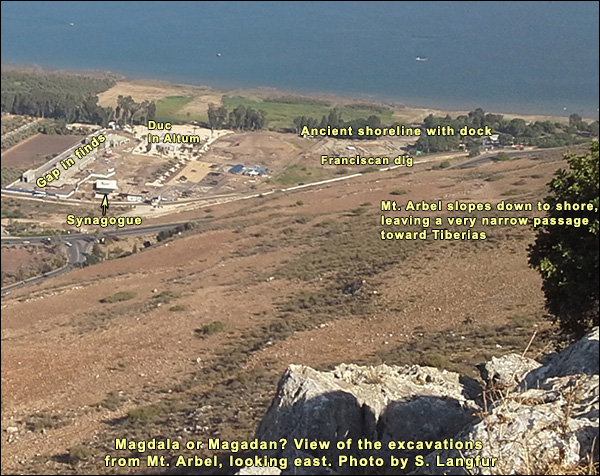
The archaeologists discovered that their area had been flooded by mud in about 67 AD. The latest coin they found in it dates from then. Unlike the Franciscan section to the south, this part was never rebuilt. The reason for the neglect was no doubt the area's vulnerability to floods: these still come today from the riverbed beneath the Arbel cliff, and the new excavations must be sandbagged. Digging a foot or so through the mud, the archaeologists discovered parts of a mosaic floor, which they initially guessed might belong to a Byzantine church. However, under the pebbles of the central floor, which was bare of mosaic at the time the mud came, they found a coin from 43 AD. Remains of a square building turned up (120 square meters), with an oblong addition on the west. The square had benches on the sides, as in ancient synagogues. Then, on top of a mosaic floor in a sideroom, they found another coin. It had the names "Tiberius" and "Herodias Tetrarch," namely Herod Antipas,This son of Herod the Great appears in the Gospels as "Herod the Tetrarch" and in Josephus as "Herod Antipas." best known to us for imprisoning and beheading the Baptist. It bore a date equivalent to 29 AD – a year before what many consider to have been the date of Jesus' crucifixion. We may conclude that the mosaic of this floor was laid before the coin fell, though of course the coin may have fallen some years after its minting. But that was not all. Out of the mud in the innermost part of the structure, a sculpted stone emerged. Nothing like it from the 1st century AD had ever been seen. It might have been modeled on a wooden chest, as Steven Fine suggests , but the top is tilted like a lectern. The reader could have sat on the floor and read from a scroll laid upon it. (Sitting on the floor would not have been unusual: according to archaeologist Jodi Magness,The Holy Land Revealed, The Great Courses, Disc 3 scribes wrote while sitting in half-yoga position with the tablet on their laps.) On the shorter and lower side of the stone – the side the reader would have been facing - is the carving of a seven-branched lampstand, a representation of the famous Menorah that stood in the Jerusalem Temple at the time when the synagogue was in use. Given this much, Mordechai Aviam"The Decorated Stone from the Synagogue at Migdal," Novum Testamentum 55 (2013), pp. 205-220 has interpreted the stone's other designs as depicting items in the Temple. Taking the sculpted stone together with the benches, we may be confident that the building was a synagogue. Here then are the ruins of a Galilean synagogue that dates approximately from the time when "Jesus went throughout Galilee preaching in the synagogues."
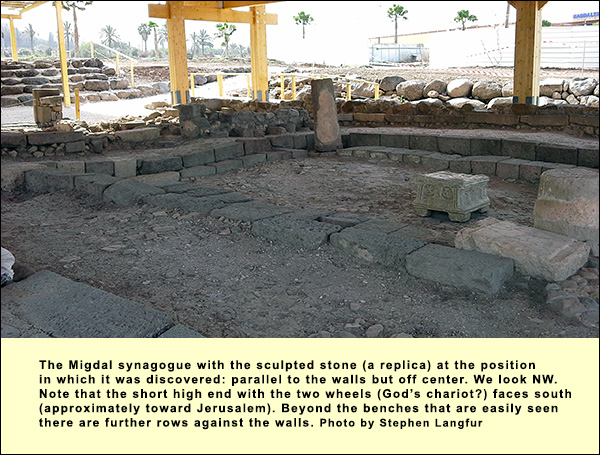
The stone's large short end shows two wheels, one with the hub protruding and the other with a hollow where the axle would fit. (On the basis of the hub and the hollow, as well as the straightness of the lines, Aviam holds that these are wheels and not rosettes.) Below each wheel are forms like triangles, but each having one side curved. Aviam sees them as flames. This brings to mind several passages in Ezekiel 10 that describe God's fiery throne in the Holy of Holies, for example, verse 6:
[T]he Lord commanded the man in linen, “Take fire from among the wheels, from among the cherubim….” The image also brings to mind the fiery wheels of the throne of God in Daniel 7:9 – Thrones were set in place, and the Ancient of Days took his seat. His clothing was as white as snow; the hair of his head was white like wool. His throne was flaming with fire, and its wheels were all ablaze. On this reading, then, the stone presents a prophetic vision of God's throne, set in the Holy of Holies. (That may help us interpret the later engraving of a building on wheels at Capernaum, with flames (?) coming in from the left.) The top of the stone has a central rosette with six petals and another six placed to join them. The rosette appears very frequently in Jewish art of 2000 years ago – more so than in any other known culture- for instance, on mosaic floors, ossuaries, and sarcophagi. We do not know why, except lamely to remark that this form of decoration was never thought to contravene the ban on images. In the Jewish War (V.5.5), Josephus wrote, "Now the twelve loaves that were upon the table [of showbread] signified the circle of the zodiac and the year." The twelve petals of this rosette may have represented completeness, cosmic completeness in the signs of the zodiac and/or national completeness in the twelve tribes of Israel. Moreover, the curious forms surrounding the rosette add up to twelve as well. Perhaps they represent the variously shaped loaves on the showbread table. As to the things that resemble trees on both sides of the rosette, some interpret them as palms, but Aviam, looking closely, sees each as a bundle of sticks wrapped with a cord; such were used for raking ash and bones from the sacrificial altar. The four corners of the top are circular and rough – various explanations have been tried, none of them very persuasive.The stone concentrates the Temple into itself. In a way, it brings the Temple to the Galilee, especially for those who could not regularly make the pilgrimage to Jerusalem. Professor Rina Talgam points out that in this synagogue, because of the seating arrangement, the community surrounded the stone as the pilgrims in Jerusalem surrounded the Temple.
As for the synagogue building itself, it is squarish, as said, containing 120 square meters. Beyond the square, on the west, is a narrow room. In it was found a plain stone that would have been suitable as a lectern. Perhaps this room was used by smaller study groups. A doorway was discovered here, and it is thought that one entered the synagogue through this room.
In the square main hall there are two rows of basalt benches, an outer row against the walls and an inner one at a lower level. Between them run corridors with mosaic floors, including an eight-petalled rosette on the east. These floors are dated between 40 and 50 AD. The central floor, however, with the sculpted stone, was found unpaved. Perhaps a new mosaic floor was being laid at the time destruction came, and this central portion had just been stripped in preparation. In the layer beneath the surface pebbles the archaeologists found the above-mentioned coin from 43 AD.
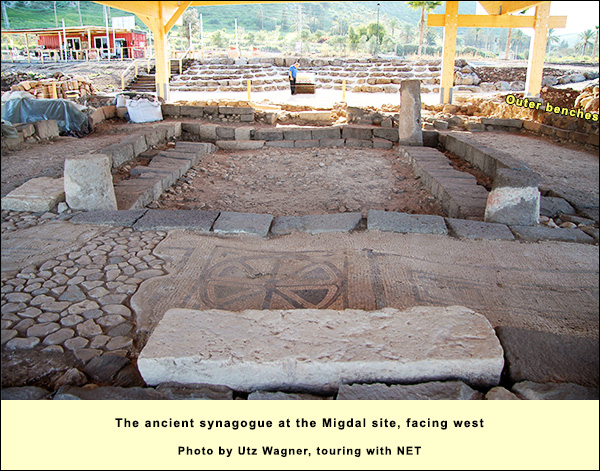
Originally the synagogue had six pillars with painted plaster, but some were re-used in a makeshift wall outside. The walls were painted, and parts of frescoes remain. The latter were done in what is called the Pompeian First Style, which imitated vividly colored marble. As you can see to the right of the rosette in the photo above, the mosaic floors have a meander pattern like those found in Jerusalem mansions from this time. The eight-petalled rosette (found also in a nearby villa) brings to mind a similar one in the mosaic floor of Herod's western palace on Masada.
Just outside the southwest corner of the square hall are remains of a small side room that may have been used to store the sacred scrolls. The archaeologists consider its mosaic to be earlier than that of the main hall, in which case there would have been at least two phases to the building. On one of its outside walls a piece of fresco is well preserved.
The small size of the synagogue raises a question. For the city was large: about 23 acres (= 9 hectares). Mendel NunAncient Anchorages and Harbours around the Sea of Galilee, Kinnereth Sailing Company, Kibbutz Ein Gev, pp. 20-21. puts the length of its southern, open dock at 100 meters, while on the north is a curving breakwater of 70 meters, protecting against the waves stirred up by the winter winds from the north and east. The southern dock includes six huge stones in situ, each with a hole bored through it - hence mooring stones. They lie in the Franciscan section, which is not yet accessible to the public. The first phase of this harbor goes back to the Hasmoneans,The Hasmoneans: family of Judah Maccabee ("the hammer") and his brothers, who revolted successfully against the Greek Empire in 167 BC. In 164 they purified and re-dedicated the Temple in Jerusalem, establishing the festival of Hanukah ("dedication"). They ruled till 63 BC, and their domain extended almost as far that attributed to King David. who founded the city in the 2nd century BC. The harbor was expanded by Herod or his son Herod Antipas, so it would have been big already at the time of our little synagogue. There are also – on the Franciscan side – remains of a Roman bathhouse, as well as a 1st century BC spring-house (once thought to be a synagogue). The Franciscans also exposed a villa urbana,A country house with the amenities of an urban mansion rich in mosaics going back as far as the 1st century AD, including a famous mosaic of a boat. To its south they excavated a large structure of many rooms, and south of that they found a colonnaded plaza extending over 900 square meters (1st century AD). West of this plaza was a paved street and an aqueduct, both Early Roman. The cemetery, lying just south of the city's southern border, is indicated by a small group of sarcophagi (3d and 4th centuries AD) on the western edge of today's main road – they were discovered in 1965, and guides have been pointing them out ever since. We are not sure where the city's north end was. The area immediately north of the synagogue has proved to be free of ruins (the hotel is going up there as I write), but it is possible that this was merely a gap, because it lay directly in the path of the floods. Indeed, there is evidence of a more extensive city to the north and west, separated from our site by an empty strip about 150 meters wide. The evidence is as follows: A surface survey by K. R. Dark"Archaeological evidence for a previously unrecognised Roman town near the Sea of Galilee," Palestine Exploration Quarterly, 145, 3 (2013), pp. 185-202 has revealed an extensive concentration of Roman and Byzantine stonework and pottery between the lake shore (starting slightly north of our site) and the modern Israeli town of Migdal, whose center is two kilometers to the west. By means of photographs and a street map, Dark shows that Migdal itself is full of ancient stonework, used as garden ornaments or merely lying about; he argues convincingly that most of the pieces were not brought in from elsewhere. "The recorded data," he writes, "suggest a large Late Hellenistic to Byzantine-period settlement extending from the hilltop on which Migdal stands today, across the fields to the shore to its east. This settlement may have contained masonry buildings, some with mosaic floors and architectural stonework…. The presence of both limestone vessel fragments and a pagan altar … suggest an Early Roman-period community of Jews and non-Jews….The newly identified settlement would include Tamar and Ilanot beaches, providing it with good natural harbours." He adds that this settlement would also include the spot where two brothers from Kibbutz Ginnosar found a 2000-year-old boat that is now displayed at the kibbutz's Yigal Allon Museum. "Compared to other, excavated and textually attested, settlements known from the Roman-period Galilee, it is hard to avoid the interpretation that such a settlement should be considered urban…. If so, then why it is located so close to 'Magdala' is enigmatic, when these sites appear to be contemporary. One explanation may be the growth of two harbour-side villages to produce adjacent urban communities. The agricultural wealth of the valley and the fishing economy of the 'Sea' might have provided the resources for such a development." Later we shall find evidence in the Bible to support the idea that there were twin cities here. Returning to our site, it is clear that it underwent a severe decline in the 4th century, probably because of the great earthquake of 363 AD.
Tarichea? Often those who name our site Magdala identify it with an important city that was known in the Greek of Josephus by the name Tarichea (Pickling Place – that is, a place where fish were salted). In the Jewish War, III, 10, Josephus gives a detailed report of a bloody sea battle at Tarichea during the First Revolt. After taking the city, VespasianGeneral chosen by Nero to put down the Jewish revolt of 66-70 AD. Roman emperor from 69-79. spared the lives of its native residents, condemning only the outsiders who had entered and fomented rebellion. In the ruins we are looking at, in fact, archaeologist S. Loffreda"Alcune Osservazioni Sulla Ceramica di Magdala," Studia Hierosolymitana, 1976, 1:338–354. found no trace of damage by the Romans at the time of the First Revolt (although others might dispute this). But is our site Tarichea?Certain factors weigh against it. First, in preparing the revolt as general of the rebels in Galilee, Josephus fortified Tarichea with a wall, but none has been found here (except a few meters of makeshift wall into which some pillars from our synagogue were recycled, but this was not thick enough and surely not high enough to serve for defense; it may have been used to block the flow of mud southward). Also, Josephus mentions a hippodrome at Tarichea, but no trace of one has yet turned up. Most tellingly, in his account of the battle (War III.10.3), Josephus reports that the Romans marched from Tiberias and spread out their troops in the plain before Tarichea. Now, Josephus knew the territory. But if we stand at our site and look south toward Tiberias - or enlarge the photo on the right - we see at once that there is no plain beyond the ruins: Mount Arbel comes down to within 60 meters of the water's edge, leaving a narrow strip that continues southward for more than a kilometer. We cannot claim that the shoreline was farther east two millennia ago, because the ancient harbor is right here. In sum, it just doesn't make sense that these ruins could have been Tarichea! On the other hand, where else could Tarichea have been? The ancient sources indicate that it was the most important city on the lakeshore before Herod Antipas built Tiberias (starting ca. 17 AD). No other candidate for it has been found. Nikos Kokkinos"The location of Tarichaea: North or south of Tiberias?" Palestine Exploration Quarterly, 142, 1 (2010), pp. 7–23. suggests a location on the southwest shore, in the plain just north of Beth Yerah. He has a textual source: The Roman historian Pliny the Elder (23-79 AD) - working from others' accounts, for he never visited the country - locates Tarichea at the southern part of the lake. This possibility must await the archaeologist. We should not dismiss the notion on the ground that we see mainly vegetation there; around Migdal too we see only crops, but Dark's surface survey has suggested the possibility of an extensive city.
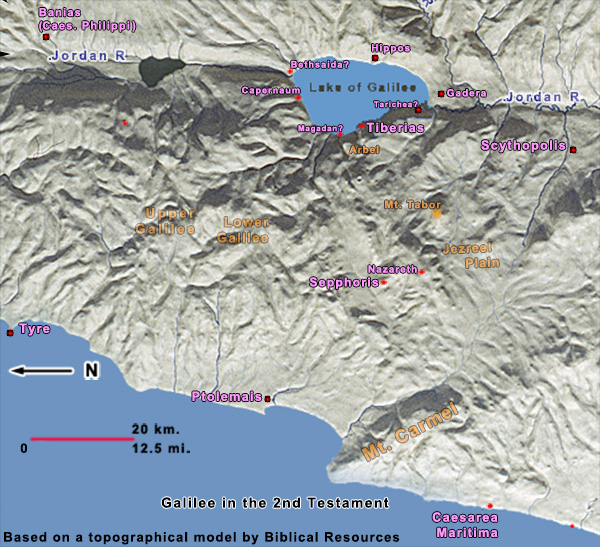
Magadan-Dalmanutha Returning to our site, Kokkinos proposes to identify it with a place which Josephus, in his Autobiography, calls in Greek "Homonoia" (Concord). Homonoia it may have been in Greek, but a line of thought leads to the idea that the place was called "Magadan" in Aramaic. The name came from the word magad, meaning "fine fruit"M. Jastrow, Dictionary of the Targumim, the Talmud Babli and Yerushalmi, and the Midrashic Literature, 1943, p. 726 – a reference to the famous fruits of the plain to the west. The logic leading to Magadan begins from the fact that from the 6th century onward, Christian pilgrims knew our site as Magdala, home town of Mary Magdalene. Earlier sources – namely, Eusebius, Jerome, and the 4th-century pilgrims - recognized no Magdala here. But there is an early source that did indeed recognize Magadan: Matthew 15:39 tells us that Jesus, having fed the four thousand, went by boat "to the borders of Magadan." The parallel in Mark (8:10) has him going by boat to the region of Dalmanutha, although Taylor"Missing Magdala and the name of Mary 'Magdalene,'" Palestine Exploration Quarterly, 146, 3 (2014), pp. 205-223 cites evidence that early variants of Mark speak instead of Magedan (sic). She suggests that the full name may have been Magadan-Dalmanutha, and that would accord with Dark's idea of twin cities here. From two verses in Mark, we can deduce that they lay on the western shore: 8:13 has Jesus departing by boat with the disciples from Dalmanutha to the "other side" of the lake, arriving at Bethsaida in 8:22. Since Bethsaida was probably on the northeastern shore, we may place Magadan-Dalmanutha on the western. Following Taylor, I suggest this: 6th-century pilgrims (or their guides!), while en route to Capernaum from Nazareth or Tiberias, passed Magadan, which was still in ruins from the earthquake of 363. They understood the name to be a corruption of Magdala. The first pilgrim to locate Magdala on the road from Tiberias to Capernaum was Theodosius in 530 AD. In the 8th century, an Anglo-Saxon nun named Hugeburc mentions that this was the Magdalene's birthplace, and she also mentions a pilgrim church called the House of the Magdalene, where Mary was relieved of her seven demons (See this source.)J. Wilkinson, Jerusalem Pilgrims before the Crusades, Warminster: Aris and Phillips, 2002. The Franciscan archaeologists have found the ruins of a Byzantine monastery. Starting in the 6th century (or perhaps already in the 5th) scribes "corrected" Matthew 15:39 to read "Magdala" instead of "Magadan." The name stuck: Until the Arab-Israeli War of 1948 there was an Arab village here called Mejdal. If Mary received the name Magdalene on the basis of a place, then it was probably a tower (magdal) in Galilee. There were many towers, however. In the 5th-century Babylonian Talmud (Pesachim 45a), a rabbi mentions migdal nuniya (Fish Tower), locating it about a kilometer ("1 mil") north of Tiberias. This would put it not at our site, but rather on the shore beneath Tel Raqqat, on the south side of Mount Arbel. Such a tower would have been used for spotting fish and directing the fishermen to them. If Migdal Nuniya already existed in the 1st century, might Mary have been known as being from there? It does not seem likely. At any distance from the place, no one would have known which of the country's many towers was referred to in her name. The watchtower of Micah 4:8 is a better explanation. Our site was probably Magadan in the first century, although it may have been known as Magadan-Dalmanutha and Homonoia in Greek. (For a detailed discussion, see Taylor.)"Missing Magdala and the name of Mary 'Magdalene,'" Palestine Exploration Quarterly, 146, 3 (2014), pp. 205-223. We return to the question as to why, serving such a large city – or even twin cities - the synagogue was so small. (It is about the same size as the 1st-century synagogues at Masada and Um El Umdan in Modiin (which is also square), but these served much smaller areas.) We may gain a hint from a dedicatory inscription that belonged to a 1st-century BC synagogue in Jerusalem. I mean the so-called Theodotos inscription, found on the spur that had earlier housed the City of David. It tells us that one Theodotos, son of Vettenos, a priest and archisynagogos – that is, head of the synagogue – built (or rebuilt) the synagogue "for the reading of the Law and for the study of the commandments." Note what is not mentioned: It does not say "for communal prayer." The indication is that synagogue buildings before the destruction of the Temple were used mainly for teaching. It was incumbent on Jews to keep the commandments, but scrolls were scarce – few could afford them – and it may also be the case that only few were learned enough to comprehend them. The size of these earliest synagogue buildings, therefore, would have been determined by how many people could be effectively instructed at once. We should probably think of them as ornate classrooms. The ruins that we see represent, therefore, a democratization of knowledge, in contrast with the Temple, where only the priests were permitted in the innermost parts. Later, to be sure – when the Temple was gone, and when the sacrifices had been transformed into prayers – the function of the synagogue changed. It then became necessary to design buildings for larger congregations engaged in communal prayer. Other structures According to an Information Sheet released by the Magdala Visitor's Center, we may interpret the area just south of the Magadan synagogue as a large market complex consisting of about twenty shops. It included a fish market. This contained several units, each having three small pools beside a deeper well with stone steps leading down. The Information Sheet reads: "You can imagine the process. The nets would have been hauled in but remained in the water to keep the fish alive. A large pool …would have held the large supplies of fish. From there the fish could be sorted into separate smaller pools for sale. The wells, fed by underground water, would have provided fresh water to replenish the smaller pools." South of the market area, the diggers uncovered the remains of luxurious houses. In some of these are Jewish ritual immersion baths (miqva'ot). They are extremely well-preserved, although the stone roofs are gone. Still today, when it rains and the groundwater rises, these baths are fed by water streaming through the layers of rock that form their sides. (For this reason they were not plastered.) The baths are connected by underducts. A drainage canal then led the water to the lake, best mikve of all.
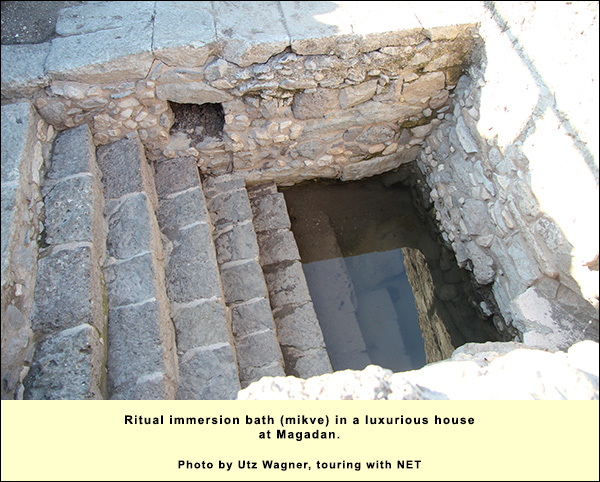
In the remains of the walls that flank the street with the drainage canal, the archaeologists found about 300 coins, all from the first century AD. Between the luxurious houses and the lake is a section that the archaeologists have dubbed "production and food area." East and south of it lay the grand harbor, its deeper part in the Franciscan excavations. In the shallow part near us, the fisherman could have docked their boats and left the net of fish in the waters, keeping them alive before sending them to the market a few paces away. Northeast of the production area is a new worship center. To this we now turn.
Duc in Altum ("Put out into the deep")
The name comes from Luke 5:1-7. Now while the multitude pressed on him and heard the word of God, he was standing by the lake of Gennesaret. He saw two boats standing by the lake, but the fishermen had gone out of them, and were washing their nets. He entered into one of the boats, which was Simon’s, and asked him to put out a little from the land. He sat down and taught the multitudes from the boat. When he had finished speaking, he said to Simon, “Put out into the deep, and let down your nets for a catch.” Simon answered him, “Master, we worked all night, and took nothing; but at your word I will let down the net.” When they had done this, they caught a great multitude of fish, and their net was breaking. They beckoned to their partners in the other boat, that they should come and help them. They came, and filled both boats, so that they began to sink.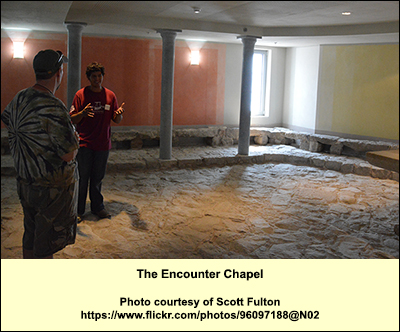
Duc in Altum is located in the harbor's market area. Surely, Simon and the other fishermen would sometimes have brought their catch here for sale. Their first encounter with Jesus may have been at this dock. The stone floor in one of the chapels, called the Encounter Chapel, is the floor of the 1st-century market. The stone benches lining its walls echo those of the synagogue nearby. Like the latter, the chapel has six pillars, and the colors of its walls are those of the synagogue frescoes. The impression is somewhat offset, however, by the lowness of the ceiling (surely the synagogue roof was higher and admitted light), and by a mural of Jesus healing the woman with a hemorrhage. The market was a place of encounter, where people of various faiths could interact. Part of the idea of Duc in Altum is to provide an opportunity for encounter among believers of all faiths.
Duc in Altum contains four small chapels, each fitting up to 50 people, as well as a main chapel, where a boat serves as altar:
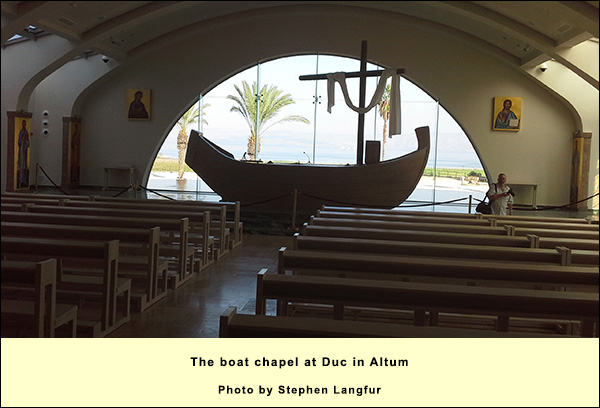
An associated theme of Duc in Altum is the celebration of woman. Seven pillars of the atrium are dedicated to women in the Jesus movement, and the eighth, unmarked, to women of all time who live by faith. The pillars support a cupola, and its base, all around, is a citation in Latin from a Letter on the Dignity of Women by Pope John Paul II. The Magdala Center translates: "The Church gives thanks to the Most Holy Trinity for the mystery of woman, and for every woman, for her eternal dignity and the wonders God has worked in her in the history of humanity."
In a letter to Father Kelly of the Magdala Center, NET's Hani Abu Dayyeh writes: "The Gospels acknowledge that women were among Jesus's earliest followers, accompanying him during his ministry and supporting him out of their private means. The details of these Gospel stories reflect the prominent historical roles that women played as disciples. Female disciples were present at the foot of the cross. They were reported to be the first witnesses to the resurrection, chief among them again Mary Magdalene. She was not only 'witness,' but also a 'messenger' of the risen Christ. The Apostles initially did not believe her witness and that of the other women, saying they 'seemed as idle tales' (Luke 24:11), until they saw Christ in Emmaus. Even then they had to touch his wounds to believe in the Resurrected Christ.
"From the beginning of Christianity, women were important members of the movement. As time went on, groups of Christians organized within the homes of believers in what came to be called House Churches. The women often opened their houses for worship. Through building up their own house-churches, women could experience relative authority, social status, political power, and renewed dignity within Paul's movement. In fact, Paul called these women 'Disciples.' Thus, those who could offer their homes for meetings, including women, were considered important within the movement and assumed leadership roles." Of special note is the mosaic in the chapel that recalls the healing of Mary Magdalene. It is based on Luke 8:1-3: Soon afterwards, he went about through cities and villages, preaching and bringing the good news of God’s Kingdom. With him were the twelve, and certain women who had been healed of evil spirits and infirmities: Mary who was called Magdalene, from whom seven demons had gone out; and Joanna, the wife of Chuzas, Herod’s steward; Susanna; and many others; who served them from their possessions.
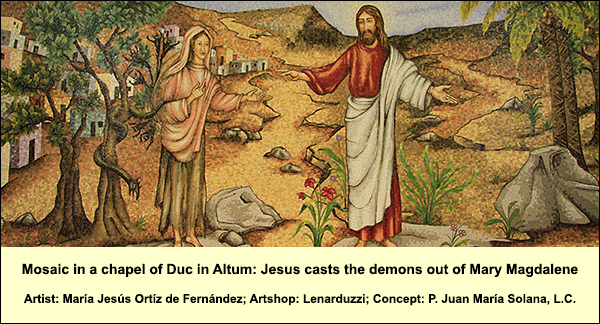
In his letter to Father Kelly, Hani Abu Dayyeh comments on this work: "Unlike Michelangelo's fresco on the ceiling of the Sistine Chapel showing God reaching out, finger pointed to touch man, here Christ is reaching his pointed finger towards Mary Magdalene, symbolizing the Second Creation of humanity through a woman. Indeed, through its architecture and artwork, Duc in Altum marks a step forward for Christianity, highlighted by the following scripture that applies to all Christian relationships, including Christian marriage: "There is neither Jew nor Greek, there is neither bond nor free, there is neither male nor female: for you are all one in Christ Jesus"(Galatians 3:28). For more on Duc in Altum, see its excellent website. Logistics The site keeps generous hours: 08:00 - 18:00. Phone: +972 4 620 9900
Email: info@magdala.org There is a small entrance fee.